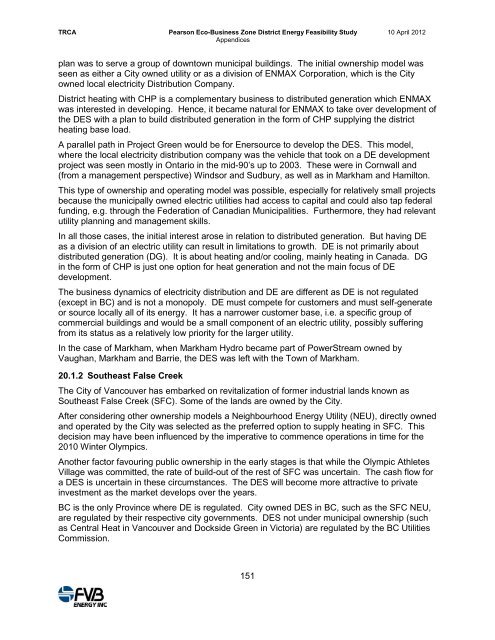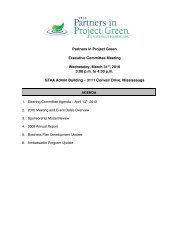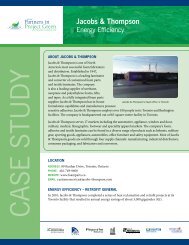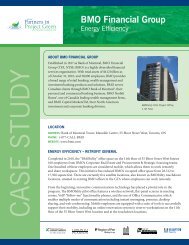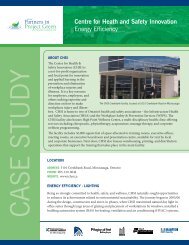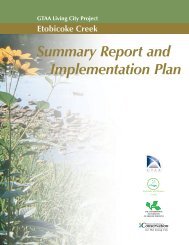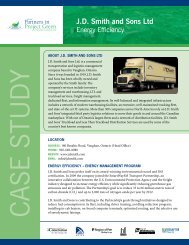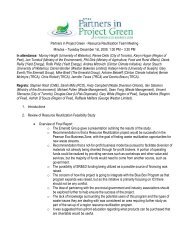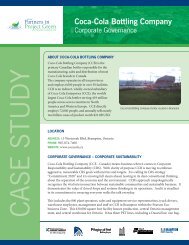Project Green District Energy Feasibility Study - Partners in Project ...
Project Green District Energy Feasibility Study - Partners in Project ...
Project Green District Energy Feasibility Study - Partners in Project ...
You also want an ePaper? Increase the reach of your titles
YUMPU automatically turns print PDFs into web optimized ePapers that Google loves.
TRCA Pearson Eco-Bus<strong>in</strong>ess Zone <strong>District</strong> <strong>Energy</strong> <strong>Feasibility</strong> <strong>Study</strong> 10 April 2012<br />
Appendices<br />
plan was to serve a group of downtown municipal build<strong>in</strong>gs. The <strong>in</strong>itial ownership model was<br />
seen as either a City owned utility or as a division of ENMAX Corporation, which is the City<br />
owned local electricity Distribution Company.<br />
<strong>District</strong> heat<strong>in</strong>g with CHP is a complementary bus<strong>in</strong>ess to distributed generation which ENMAX<br />
was <strong>in</strong>terested <strong>in</strong> develop<strong>in</strong>g. Hence, it became natural for ENMAX to take over development of<br />
the DES with a plan to build distributed generation <strong>in</strong> the form of CHP supply<strong>in</strong>g the district<br />
heat<strong>in</strong>g base load.<br />
A parallel path <strong>in</strong> <strong>Project</strong> <strong>Green</strong> would be for Enersource to develop the DES. This model,<br />
where the local electricity distribution company was the vehicle that took on a DE development<br />
project was seen mostly <strong>in</strong> Ontario <strong>in</strong> the mid-90’s up to 2003. These were <strong>in</strong> Cornwall and<br />
(from a management perspective) W<strong>in</strong>dsor and Sudbury, as well as <strong>in</strong> Markham and Hamilton.<br />
This type of ownership and operat<strong>in</strong>g model was possible, especially for relatively small projects<br />
because the municipally owned electric utilities had access to capital and could also tap federal<br />
fund<strong>in</strong>g, e.g. through the Federation of Canadian Municipalities. Furthermore, they had relevant<br />
utility plann<strong>in</strong>g and management skills.<br />
In all those cases, the <strong>in</strong>itial <strong>in</strong>terest arose <strong>in</strong> relation to distributed generation. But hav<strong>in</strong>g DE<br />
as a division of an electric utility can result <strong>in</strong> limitations to growth. DE is not primarily about<br />
distributed generation (DG). It is about heat<strong>in</strong>g and/or cool<strong>in</strong>g, ma<strong>in</strong>ly heat<strong>in</strong>g <strong>in</strong> Canada. DG<br />
<strong>in</strong> the form of CHP is just one option for heat generation and not the ma<strong>in</strong> focus of DE<br />
development.<br />
The bus<strong>in</strong>ess dynamics of electricity distribution and DE are different as DE is not regulated<br />
(except <strong>in</strong> BC) and is not a monopoly. DE must compete for customers and must self-generate<br />
or source locally all of its energy. It has a narrower customer base, i.e. a specific group of<br />
commercial build<strong>in</strong>gs and would be a small component of an electric utility, possibly suffer<strong>in</strong>g<br />
from its status as a relatively low priority for the larger utility.<br />
In the case of Markham, when Markham Hydro became part of PowerStream owned by<br />
Vaughan, Markham and Barrie, the DES was left with the Town of Markham.<br />
20.1.2 Southeast False Creek<br />
The City of Vancouver has embarked on revitalization of former <strong>in</strong>dustrial lands known as<br />
Southeast False Creek (SFC). Some of the lands are owned by the City.<br />
After consider<strong>in</strong>g other ownership models a Neighbourhood <strong>Energy</strong> Utility (NEU), directly owned<br />
and operated by the City was selected as the preferred option to supply heat<strong>in</strong>g <strong>in</strong> SFC. This<br />
decision may have been <strong>in</strong>fluenced by the imperative to commence operations <strong>in</strong> time for the<br />
2010 W<strong>in</strong>ter Olympics.<br />
Another factor favour<strong>in</strong>g public ownership <strong>in</strong> the early stages is that while the Olympic Athletes<br />
Village was committed, the rate of build-out of the rest of SFC was uncerta<strong>in</strong>. The cash flow for<br />
a DES is uncerta<strong>in</strong> <strong>in</strong> these circumstances. The DES will become more attractive to private<br />
<strong>in</strong>vestment as the market develops over the years.<br />
BC is the only Prov<strong>in</strong>ce where DE is regulated. City owned DES <strong>in</strong> BC, such as the SFC NEU,<br />
are regulated by their respective city governments. DES not under municipal ownership (such<br />
as Central Heat <strong>in</strong> Vancouver and Dockside <strong>Green</strong> <strong>in</strong> Victoria) are regulated by the BC Utilities<br />
Commission.<br />
151


